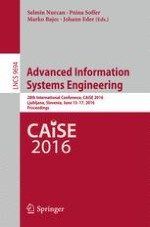This book constitutes the proceedings of the 28th International Conference on Advanced Information Systems Engineering, CAiSE 2016, held in Ljubljana, Slovenia, in June 2016.
The 35 papers presented in this volume were carefully reviewed and selected from 211 submissions.
The program included the following paper sessions:
Collaboration, Business Process Modeling. Innovation, Gamication, Mining and Business Process Performance, Requirements Engineering, Process Mining, Conceptual Modeling, Mining and Decision Support, Cloud and Services, Variability and Configuration, Open Source Software, and Business Process Management.
